Where will Ethereum head by 2030? How will the vision of the world ledger materialize in this division of Rollup technology?
Author: Lemniscap
Compiled by: Saoirse, Foresight News
A more streamlined L1 and its performance-oriented and aligned Rollup solutions
Ethereum has always been committed to maintaining trusted neutrality while allowing higher-level innovations to thrive. Early discussions outlined a "Rollup-centric roadmap," where the underlying network would gradually simplify and solidify, so that most activities could migrate to L2. However, recent developments indicate that merely acting as a minimized consensus and data availability layer is insufficient: L1 must have the capability to handle traffic and activities, as this is the foundation that L2 ultimately relies on. This means faster block generation speeds, lower data costs, more robust proof mechanisms, and better interoperability are needed.
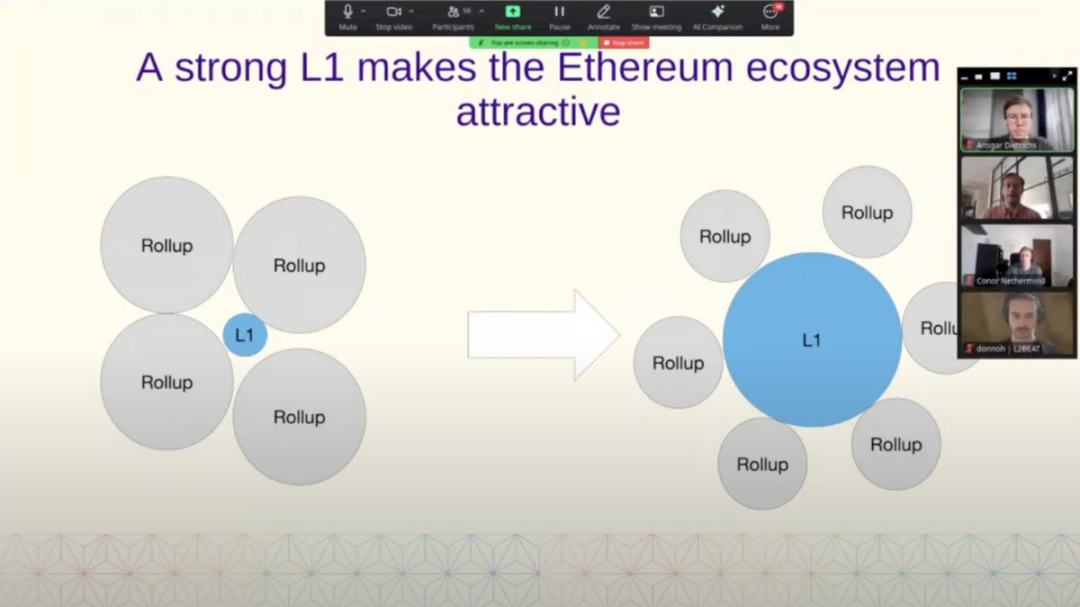
The increased activity of L1 will drive the growth of L2 activity, truly raising all boats.
Source: https://www.youtube.com/live/EvYRiFRYQ9Q?si=bsLWGA6FP9pi2vqI&t=477
The upcoming Beam Chain consensus mechanism reconstruction aims to achieve faster finality speeds and lower validator thresholds while enhancing Ethereum's neutrality while improving raw throughput. Meanwhile, proposals have already considered migrating activities from the increasingly outdated (and "increasingly complex") Ethereum Virtual Machine (EVM) to a RISC-V native virtual machine, which is expected to significantly improve proof efficiency while maintaining interoperability with traditional contracts.
These upgrades will reshape the L2 landscape. By 2030, I expect Ethereum's Rollup-centric roadmap to consolidate in two directions within a range:
Aligned Rollups: Prioritize deep integration with Ethereum (such as shared ordering, native validation), fully utilizing L1's liquidity while minimizing trust assumptions. This relationship is mutually beneficial; aligned Rollups can directly obtain composability and security from L1.
Performance Rollups: Prioritize throughput and real-time user experience, sometimes achieving this through alternative data availability layers (DA layers) or authorized participants (such as centralized sorters, small security committees/multi-signature), but still rely on Ethereum as the final settlement layer for credibility (or for marketing purposes).
In designing these Rollup solutions, each team must balance the following three aspects:
Liquidity acquisition: How to obtain and use liquidity on Ethereum and potentially other Rollup solutions? How important is synchronous or atomic-level composability?
Source of security: To what extent should liquidity moving from Ethereum to Rollups directly inherit Ethereum's security, or rely on Rollup providers?
Execution expressiveness: How important is Ethereum Virtual Machine (EVM) compatibility? Given the rise of alternatives like SVM and popular Rust smart contracts, will EVM compatibility remain important in the next five years?
Polarization on the Rollup spectrum
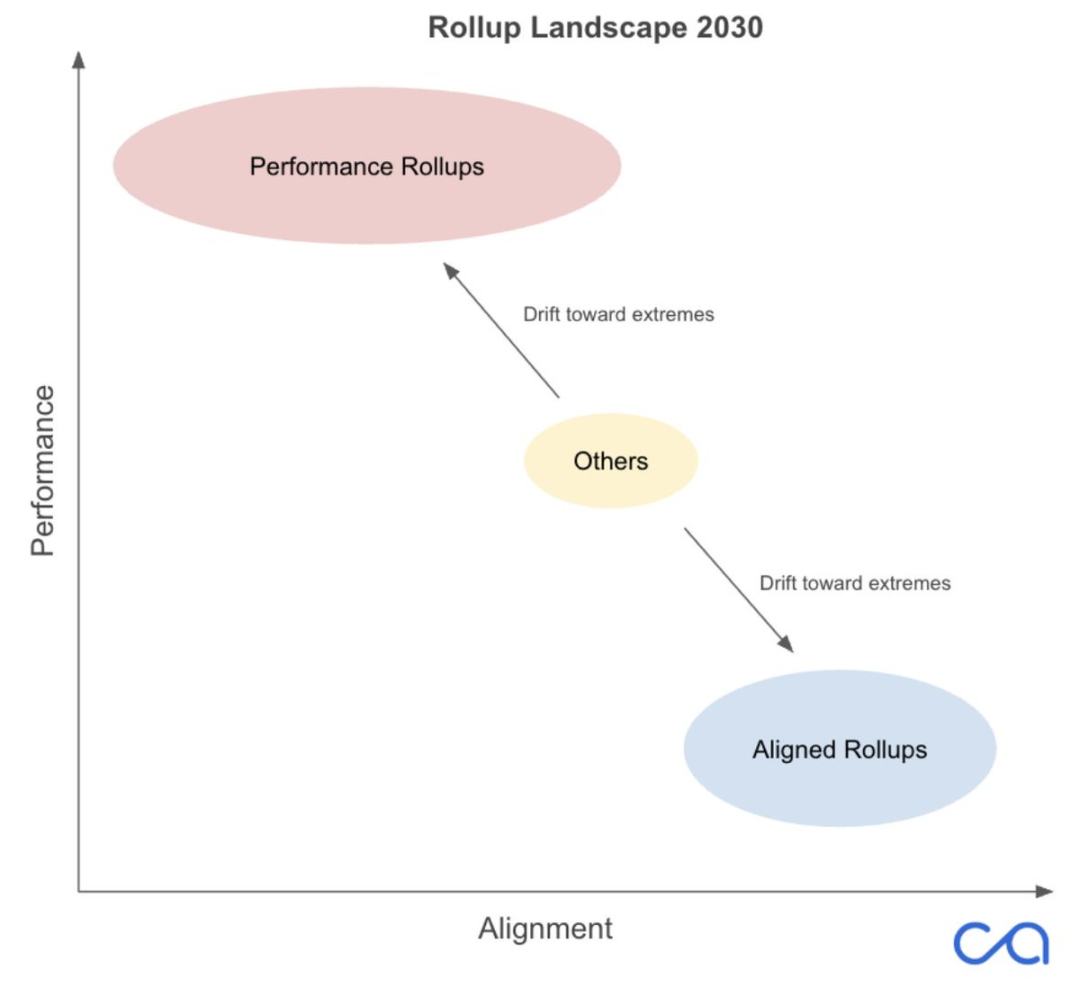
Rollup projects are gradually clustering towards two extremes. On one end are high-performance Rollups that can provide maximum throughput and user experience (high bandwidth, low latency), but have a lower coupling with Ethereum L1; on the other end are Ethereum-aligned Rollups (such as L1-based Rollups, native Rollups, super-rollups), which fully utilize Ethereum's security, data, and consensus mechanisms, prioritizing decentralization, security, and trusted neutrality, but may sacrifice some performance due to L1 design constraints. Rollups in the middle ground, attempting to balance both, may struggle to compete and ultimately lean towards one extreme, facing the risk of being eliminated.
The Rollup in the upper left corner focuses on performance: they may adopt centralized sorters, alternative data availability networks (DA networks), or specific application optimizations to achieve throughput far beyond conventional L2 (such as MegaETH). Some performance-oriented Rollups may lean more towards alignment (for example, by adopting technologies like Puffer UniFi and Rise based on fast pre-confirmation, targeting the top right "ideal target"), but their ultimate determinism still depends on L1's specifications. In contrast, the Rollup in the lower right corner maximizes alignment with Ethereum: deeply integrating ETH into fees, transactions, and DeFi; cementing transaction ordering and/or proof verification in L1; and prioritizing composability over raw speed (for example, Taiko is evolving in this direction but is also exploring permissioned pre-confirmation to optimize user experience). By 2030, I expect many "moderate" L2s to either shift towards one of the above patterns or face the risk of elimination. Users and developers will tend to choose high-security, Ethereum-aligned environments (for high-risk and composable DeFi scenarios) or highly scalable, application-customized networks (for mass user applications). Ethereum's 2030 roadmap lays the foundation for both paths.
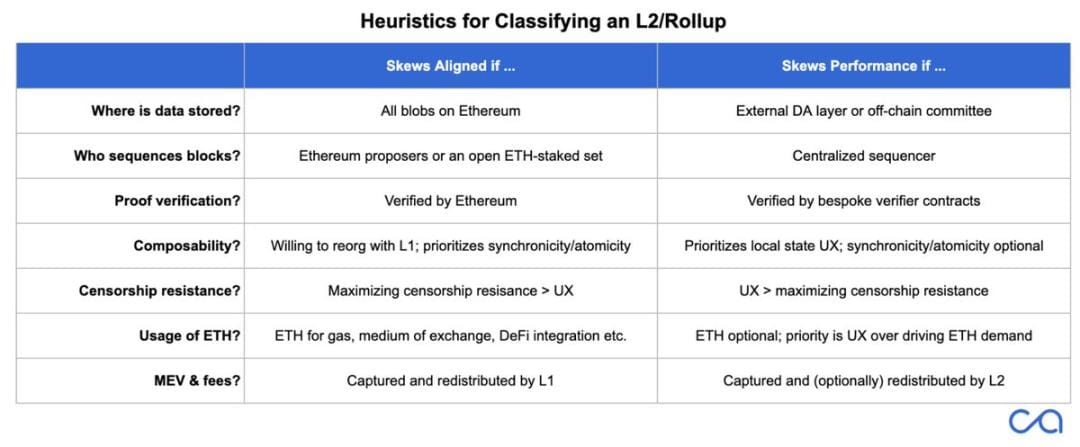
The definition of "alignment" is contentious and lacks consensus. For the purposes of this report, the above is a brief analytical framework on "performance" and "alignment." The previous charts are based on this definition and may not apply to other interpretations of "alignment."
Why will the middle ground disappear?
Network effects will drive the market towards fewer, larger hubs. In markets where network effects dominate, like cryptocurrency, a pattern dominated by a few winners may ultimately form (similar to what we see in the CEX sector). Because network effects tend to concentrate around the core advantages of a chain, ecosystems often consolidate towards a few platforms that maximize "performance" and "security." A Rollup that only achieves mediocre alignment with Ethereum or performance may ultimately lack the security of the former and the usability of the latter.
As Rollup technology matures, economic activities will stratify based on the trade-off between "required security" and "cost of obtaining security." Scenarios unable to bear settlement or governance risks, such as institutional-level DeFi, large on-chain vaults, high-value collateral markets, etc., may concentrate on chains inheriting Ethereum's complete security guarantees and neutrality (or Ethereum L1 itself). On the other end, applications aimed at the general public (like memes, trading, social, gaming, retail payments, etc.) will cluster on chains that offer the best user experience and lowest costs; these chains may require customized throughput enhancement solutions or centralized ordering mechanisms. Therefore, those "moderately fast but not the fastest, reasonably secure but not optimal" general-purpose chains will gradually lose their appeal. Especially by 2030, if cross-chain interoperability allows assets to flow freely between these two types of scenarios, the survival space in this middle ground will be even more limited.
Evolution of Ethereum's tech stack
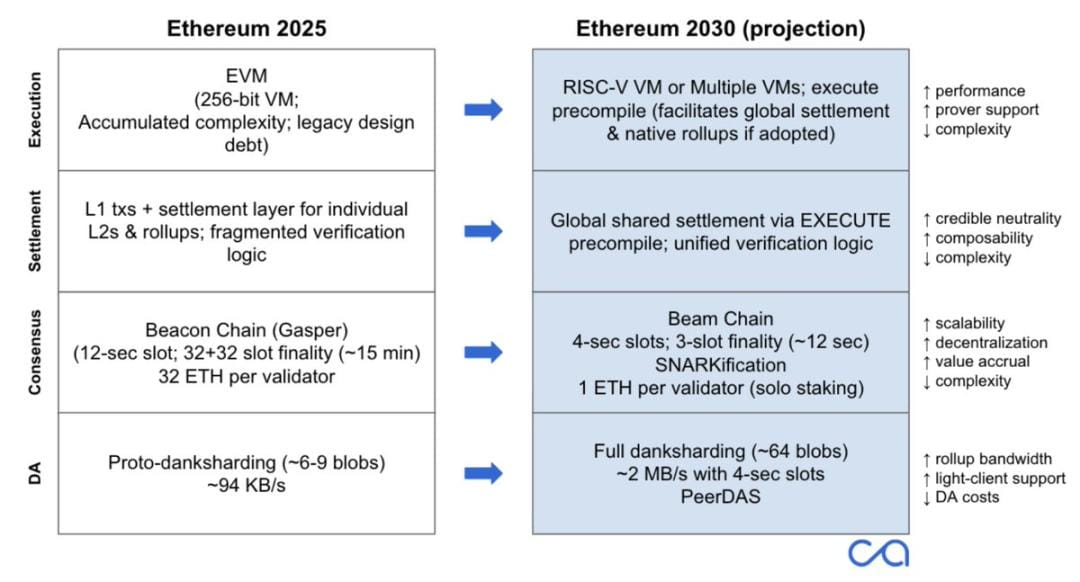
The entire foundational layer of Ethereum (from execution, settlement, consensus to data availability) is planned for major upgrades aimed at enhancing L1's scalability and better adapting to the Rollup-centric development model. Key improvements (as indicated by arrows) will enhance performance, reduce complexity, and promote Ethereum's more direct role in Rollup operations.
Execution Layer
By 2030, Ethereum's current execution environment (using 256-bit architecture and traditional design of the Ethereum Virtual Machine EVM) may be replaced or enhanced by a more modern and efficient virtual machine. Vitalik has proposed upgrading the Ethereum Virtual Machine to a RISC-V based architecture. RISC-V is a streamlined modular instruction set that is expected to achieve significant breakthroughs in transaction execution and proof generation efficiency (improving by 50-100 times). Its 32/64-bit instructions can be directly adapted to modern CPUs and are more efficient in zero-knowledge proofs. To mitigate the impact of technological iterations and avoid stagnation (for example, the previous community's consideration of using eWasm to replace EVM), a dual virtual machine model is planned: keeping EVM to ensure backward compatibility while introducing a new RISC-V virtual machine to handle new contracts (similar to Arbitrum Stylus's compatibility scheme for WASM + EVM contracts). This aims to significantly simplify and speed up the execution layer while enhancing L1's scalability and Rollup support capabilities.
Why do this?
The design of EVM did not consider zero-knowledge proofs, so zk-EVM provers incur significant overhead when simulating state transitions, calculating root hashes/hash trees, and handling EVM-specific mechanisms. In contrast, the RISC-V virtual machine employs more straightforward register logic, allowing for direct modeling and proof generation, significantly reducing the required constraints. Its friendliness to zero-knowledge proofs can eliminate inefficient links such as gas calculations and state management, greatly benefiting all Rollups utilizing zero-knowledge proofs: the generation of state transition proofs will be simpler, faster, and lower cost. Ultimately, upgrading EVM to a RISC-V virtual machine can enhance overall proof throughput, enabling L1 to directly verify L2 executions (detailed below), while also raising the upper limit of throughput for performance-oriented Rollups.
Additionally, this will break through the niche of Solidity/Vyper, significantly expanding Ethereum's developer ecosystem and attracting more mainstream developer communities such as Rust, C/C++, and Go.
Settlement Layer
Ethereum plans to shift from fragmented L2 settlement models to a unified, natively integrated settlement framework, which will fundamentally change how Rollups are settled. Currently, each Rollup must deploy independent L1 verification contracts (fraud proofs or validity proofs), which are highly customized and independent of each other. By 2030, Ethereum may integrate a native function (the proposed EXECUTE precompiled function) as a universal L2 execution validator. EXECUTE allows Ethereum validators to directly re-execute Rollup's state transitions and verify their correctness, essentially "cementing" the capability to verify any Rollup block at the protocol layer.
This upgrade will give rise to "native Rollups," essentially programmable execution sharding (similar to NEAR's design). Unlike ordinary L2, standard Rollups, or L1-based Rollups, the blocks of native Rollups are verified by Ethereum's own execution engine.
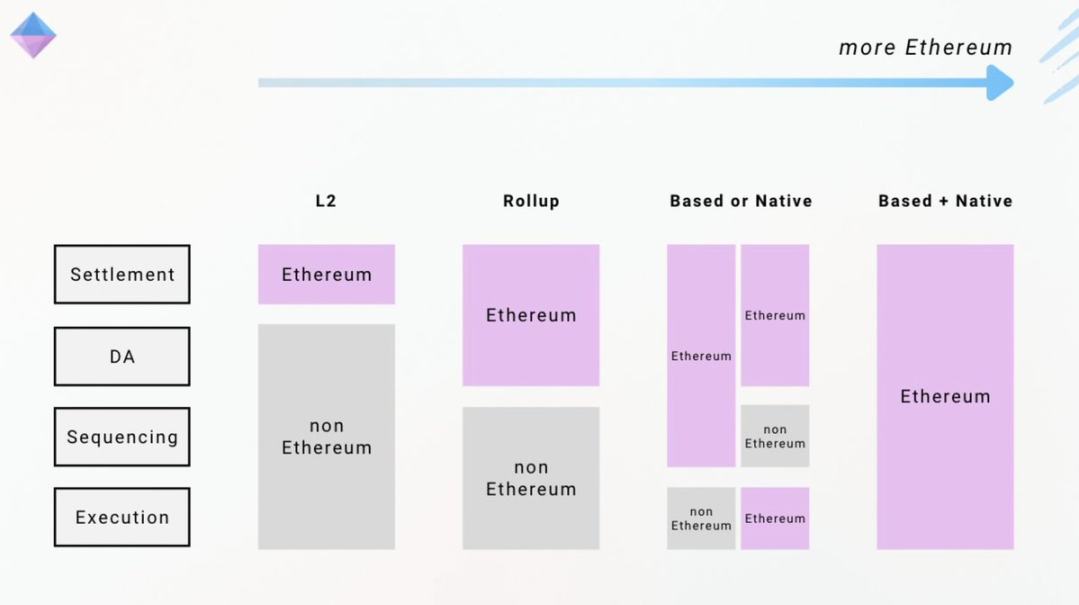
Source: https://x.com/Spire_Labs/status/1915430799618564394
EXECUTE eliminates the complex custom infrastructure required for EVM simulation and maintenance (such as fraud proof mechanisms, zero-knowledge proof circuits, multi-signature "security committees"), significantly simplifying the development of equivalent EVM Rollups, ultimately achieving a completely trustless L2 with almost no custom code. Combined with next-generation real-time provers (such as Fermah, Succinct), real-time settlements can be achieved on L1: once Rollup transactions are included in L1, finality is reached without waiting for fraud proof window periods or multi-period proof calculations. By building the settlement layer as a globally shared infrastructure, Ethereum enhances trusted neutrality (users can freely choose verification clients) and composability (without concerns about real-time proof issues in the same slot, synchronous composability is greatly simplified). All native (or native + L1-based) Rollups will use the same L1 settlement function, facilitating standardized proofs and seamless interaction between Rollups (shards).
Consensus Layer
Ethereum's Beacon Chain consensus layer is being reconstructed as Beam Chain (planned for testing between 2027-2029), aiming to upgrade the consensus mechanism through advanced cryptography (including quantum resistance) to enhance scalability and decentralization. Among the six research direction upgrades, the core features relevant to this article include:
Shorter slots, faster finality: One of Beam Chain's core goals is to improve finality speed. Reducing the current approximately 15-minute finality (two epochs under the Gasper mechanism, i.e., 32+32 12-second slots) to 3-slot finality (3SF, 4-second slots, about 12 seconds), ultimately achieving single-slot finality (SSF, about 4 seconds). 3SF + 4-second slots mean that final confirmation can be achieved within 10 seconds after a transaction is on-chain, significantly improving the user experience for L1-based Rollups and native Rollups: the speed of L1 blocks will directly accelerate Rollup block generation. The time for transactions to be included in blocks is about 4 seconds (longer under high load), making the relevant Rollup block speed increase by 3 times (though still slower than performance-oriented Rollups, alternative L1, or credit card payments, hence the importance of pre-confirmation mechanisms). Faster L1 finality will also ensure and accelerate settlements: Rollups can achieve rapid withdrawals by completing final confirmations on L1 state submissions within seconds, reducing the risks of reorganization or forks. In short, the irreversibility of Rollup transaction batch processing will be reduced from 15 minutes to seconds.
Reducing consensus costs by SNARKification: Beam plans to "SNARKify" the state transition function, allowing each L1 block to carry a succinct zk SNARK proof. This is a prerequisite for achieving synchronized, programmable execution sharding. Validators can verify blocks and aggregate BLS signatures (and future quantum-resistant signatures) without processing each transaction, significantly reducing the computational cost of consensus (while lowering hardware requirements for validators).
Lowering staking thresholds to enhance decentralization: Beam plans to reduce the minimum staking amount for validators from 32 ETH to 1 ETH. Combined with the separation of provers and proposers (APS, transferring MEV to on-chain auctions) and SNARKification, distributed anti-collusion block construction can be achieved, no longer favoring large staking pools (like Lido, which holds 25% market share), instead supporting more independent stakers using devices like Raspberry Pi. This will enhance decentralization and trusted neutrality, directly benefiting aligned Rollups. Under the APS mechanism, the number of proposers will decrease, but the inclusion list (FOCIL) will strengthen anti-censorship capabilities: once a prover includes a transaction in the list, even a small-scale, globally distributed group of proposers cannot exclude these transactions.
All of this points to the future of Ethereum's foundational layer: it will possess stronger scalability and decentralization. Particularly, L1-based Rollups will benefit the most from these consensus upgrades, as L1 will be better suited to their transaction ordering needs. By sorting transactions on L1, the Maximum Extractable Value (MEV) from L1-based Rollups (and native L1-based Rollups) will naturally flow to Ethereum block proposers, and this value can be burned, thus concentrating more value accumulation back to ETH rather than flowing to centralized sorters.
Data Availability Layer (DA Layer)
Data Availability (DA) throughput is key to Rollup scaling, especially for future performance-oriented Rollups that need to support over 100,000 TPS. Ethereum's Proto-danksharding (Dencun + Pectra upgrade) has already increased the target and maximum number of blobs per block to 6 and 9, respectively, enabling blob data capacity to reach 8.15 GB/day (approximately 94 KB/s, 1.15 MB/block), but this remains insufficient. By 2030, Ethereum may achieve complete danksharding with a target of 64 blobs per block (each 128 KB), translating to about 8 MB every 4 seconds (2 MB/s).
Although this is a tenfold improvement, it still cannot meet the performance-oriented Rollup's demand of ~20 MB/s like MegaETH. However, Ethereum's roadmap includes more upgrades: implementing Data Availability Sampling (DAS) through solutions like PeerDAS (expected in the second half of 2025 to the first half of 2026), allowing nodes to verify availability without downloading full data, and combining data sharding to increase the target blob size for each block to 48+. Under ideal conditions with Danksharding and DAS support, Ethereum can achieve a data processing capacity of 16 MB in 12-second slots, corresponding to about 7,400 simple transactions per second, which can reach 58,000 TPS after compression (like aggregated signatures, address compression), and even higher when combined with Plasma or Validium (only on-chain state roots rather than full data). Although off-chain scaling presents trade-offs in security and scalability (such as operator negligence risks), by 2030, Ethereum is expected to offer diversified DA options at the protocol layer: providing complete on-chain data guarantees for security-focused Rollups and external DA access flexibility for scalability-focused Rollups.
In summary, Ethereum's data availability (DA) upgrades are increasingly making it suitable for Rollups. However, it should be noted that Ethereum's current throughput is still far from sufficient to support high-frequency scenarios such as payments, social interactions, and gaming. Even a simple ERC-20 transfer requires about 200 bytes of blob data, which roughly calculates to about 20MB/s of raw DA bandwidth; while more complex transactions (like Uniswap swaps) will create larger state differences, requiring bandwidth to increase to about 60MB/s! Relying solely on complete Danksharding technology is insufficient to meet these bandwidth requirements, thus throughput improvement needs to rely on a clever combination of data compression and off-chain expansion.
During this period, performance-oriented Rollups will need to rely on alternative DA solutions like Eigen DA. These solutions currently provide around 15MB/s throughput and plan to increase to 1GB/s; while emerging solutions like Hyve promise to achieve 1GB/s of modular DA and support sub-second availability. It is these DA solutions that will enable Web3 applications to match the speed and user experience of Web2.
The vision of Ethereum as a world ledger
"Ethereum aims to become the world ledger: a platform for storing human civilization's assets and records, serving as the foundational layer for finance, governance, high-value data certification, and other fields. This requires two core capabilities: scalability and risk resistance." — Vitalik
By 2030, with core protocol upgrades and a Rollup-centric technological evolution, Ethereum will be more capable of fulfilling this role. As mentioned earlier, the full tech stack upgrades will support two types of Rollup models: one leaning towards "deep Ethereum integration," focusing on security and trusted neutrality; the other leaning towards "light Ethereum integration," aiming for extreme throughput and economic independence. Ethereum's roadmap does not mandate a single path but provides sufficiently flexible soil for both models to flourish.
Aligned Rollups: Ensuring high-value, highly related applications continue to receive strong security guarantees from Ethereum. Among them, L1-based Rollups can achieve Ethereum-level activity, with L1 validators responsible for transaction ordering while generating Rollup blocks; native Rollups have Ethereum-level execution security, where every Rollup state transition is re-executed and verified within L1; while native L1-based Rollups (also known as super-rollups, i.e., execution sharding) combine 100% execution security and 100% activity, essentially becoming part of Ethereum L1. These types of Rollups will drive the value accumulation of Ethereum L1: the MEV (Maximum Extractable Value) generated by L1-based Rollups flows directly to Ethereum validators, and the MEV burn mechanism can enhance ETH's scarcity; invoking the EXECUTE precompiled function to verify native Rollup proofs requires gas, creating new channels for value inflow to ETH. If the majority of DeFi and institutional finance in the future operates on a few aligned Rollups, ETH will capture the fees of the entire economy. Ethereum's resistance to censorship and MEV value capture mechanisms are the two key pillars for it to become the "world ledger".
Performance Rollups: Allowing the Ethereum ecosystem to cover all categories of blockchain applications, including scenarios requiring large-scale processing capabilities. These chains are likely to become the mainstream adoption bridge, although they may introduce (semi) trust elements, but still rely on Ethereum as the final settlement layer and interoperability hub. The coexistence of performance-oriented and aligned Rollups enables the Ethereum ecosystem to support both top-tier security and top-tier throughput applications. The heterogeneity and interoperability of L2 are more beneficial than detrimental to Ethereum: although these Rollups have a weaker economic tie to ETH, they can still stimulate new demand for ETH by using ETH as gas tokens, transaction mediums, DeFi pricing units, and core assets for new applications in high-capacity environments. Notably, as previously mentioned, Ethereum's DA layer may support over 100,000 TPS, which implies that even performance-oriented chains may ultimately return to Ethereum's DA layer rather than relying on modular alternatives (for reasons such as ecological synergy, trusted neutrality, and simplification of tech stacks). Of course, if they need to save costs or improve performance, they can still choose other DA solutions, but the core point is that advancements in Ethereum's DA layer, data compression, and off-chain data management will continue to enhance L1's competitiveness.
Exceptional cases mainly involve Rollups deeply tied to trustworthy enterprises (such as Coinbase's Base, Robinhood's L2 network Robinhood Chain), where users trust these enterprises more than trustless systems (this effect is particularly evident among new and non-technical users). In this case, the reputation and accountability mechanisms of the associated enterprises become the primary guarantees, allowing such Rollups to maintain competitiveness while weakening Ethereum's alignment, as users are willing to "trust the brand" as they do in Web2. However, their degree of adoption largely depends on B2B trust— for example, JPMorgan's chain may trust Robinhood Chain more than Ethereum and the stronger guarantees provided by aligned Rollups.
In addition, the integration of middle-ground Rollups towards two extremes is likely a natural result of the maturation of these two paths. The reason is simple: middle-ground solutions cannot achieve high alignment nor top performance. Users focusing on security and composability will choose Rollups closer to Ethereum; while users valuing low cost and high speed will lean towards optimal performance platforms. Furthermore, as pre-confirmation technologies upgrade, slot speeds increase, and L1 finality accelerates, the performance of aligned Rollups will continue to improve, and the demand for "moderate performance" will further decline. Overall, the former is more suitable for institutional DeFi, while the latter is more suitable for retail-level applications.
Successfully operating Rollups requires substantial resources (from attracting liquidity to maintaining infrastructure), and by 2030, integrations will become more frequent, with strong networks absorbing the communities of weaker networks. This trend has already begun to emerge. In the long run, an ecosystem composed of a few core hubs with clear value propositions will outperform hundreds of homogenized systems.
Special thanks to mteam, Patrick, Amir, Jason, Douwe, Jünger, and Bread for their helpful discussions and feedback!




